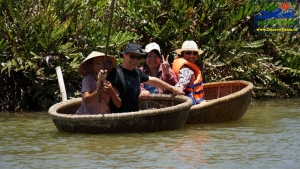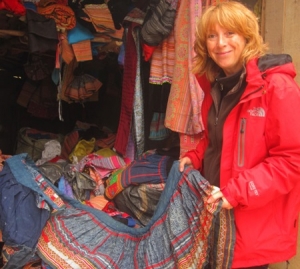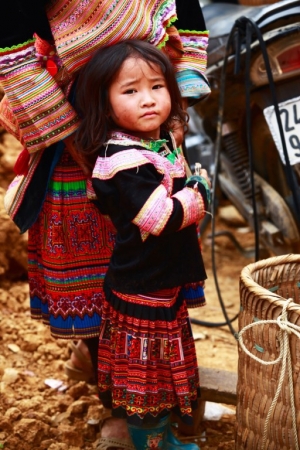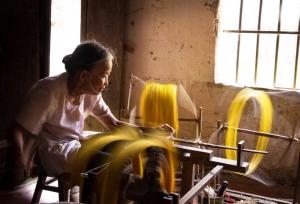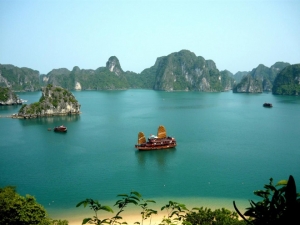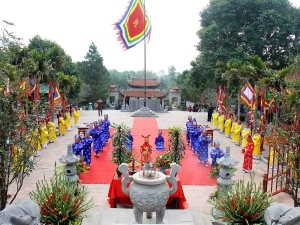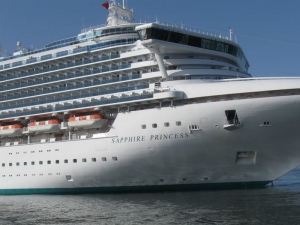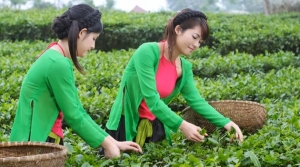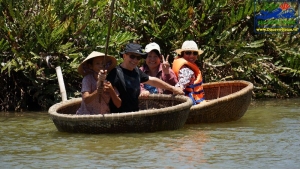
Asia Pacific Travel Team
Diversify tourism in Hoi An
The palms along the banks of the Thu Bon River are used for producing medicine, hats, alcohol, sugar, vinegar and even fuel.
The nipa forests and Cham Island have been recognised as world bio-reserves, and the forests protect the 2,000 Cam Thanh villagers from storms.
On a 10,000sq.m aquaculture farm in Cam Thanh Village at the mouth of Thu Bon River, Nguyen Tuan Lien has opened an eco-tour for weekend retreats and fishing.
Lien, 35, was born in Cam Thanh, but his family's traditional trades such as fishing and handicrafts have made way for tourism services as they are more lucrative with less risks. Lien started the Hoi An Eco Discovery Tour to offer short-stay tourists the chance to explore Hoi An and Cam Thanh in a day.
"It's a community service," Lien said.
40 villagers are employed to cycle guests around Hoi An, paddle coracle boats through the nipa forests, fish with them on Thu Bon River and cook for them on their farms.
"Villagers provide a history of the forest and explain local customs while they paddle through the nipa forests. Each of our 45 boats carries two tourists and a guide," Lien said.
Tours usually start with a cycling trip around Hoi An early in the morning. Le Duc Long, the tour manager, said tourists could enjoy a peaceful time at the UNESCO-recognised world heritage site.
The city promotes the use of bicycles in the city by banning motor vehicles from the Old Quarter for most of the day," Long said.
Long said Cam Thanh Village also offered visitors a chance to learn some farming and cooking skills.
"After visiting the old town, visitors take a 3km ride to Cam Thanh Village to change from road to river. Coracles docked at the village wharf are ready to explore the nipa forest," he said.
Village guides show visitors around the nipa forests and make hats from leaves for them.
"Tourists can also harvest snails, oysters and shrimp while walking along river banks when the tide is low," said tour guide Nguyen Cong Tai.
Tai, 30, who started fishing as a teenager, said he also taught visitors how to paddle the coracle boats.
He also demonstrated a wild dance using his feet to rotate the little vessel in tango, rock and ‘Gangnam' styles.
"It's hard because you get dizzy after a few minutes. I perform for four minutes, but tourists like to play games and test their skills by dancing in a coracle," he said.
Tourists are also taught how to manouevre the coracles without a paddle, using their hands to rock the little craft.
Nguyen Thi Phuc joined a 20-member team to explore Hoi An and Cam Thanh Village. She was happy with the fishing lessons and games at the farm.
The lunch menu offered grilled chicken, fish, shrimp and clams. Farm "waiters" used the coracles to carry food across the water to huts scatted around the farm.
Lien said the dining huts were built around the farm and connected by bamboo bridges.
"It's a bit of a challenge for visitors to walk on a single bamboo pole and handrail. They have lunch in the huts they have helped to cook with the villagers," Lien said.
"Local food, including pan cakes, spring rolls, my quang (local noodles), maize soup and bean curd are always on the menu.
Sometimes, visitors order food among the trees in the nipa forest so that they can have a relaxing and quiet time," he said.
Nguyen Van Dai, 56, head cook on the farm, said grilled oysters and chicken were the most popular dishes with visitors.
"Visitors love cooking crabs, clams and fish caught on the farm or in the nipa forest," Dai said.
A one-day tours costs about VND750,000 (US$35) per person.
City clothing, jewellery designer favours ethnic minority fabrics
Australian designer Cynthia Mann walks along the beach in her bare feet with a large, brimmed bamboo hat. The hot sun doesn't seem to bother her, as she has lost herself searching for treasures along the shore. From time to time she kneels down, picks something up and smiles to herself. She finds broken pieces of ceramics or glass, revealed by their twinkling as they reflect the sun's rays between waves.
Most would ignore the small objects. But for Mann, they're inspiration for new jewellery designs.
During a holiday on the beach, she might collect dozens of pieces. She reshapes them and frames them with silver, turning them into ornamental wares for her brand Future Traditions.
Mann has designed ornamental wares this way for more than a year. Her jewellery is purchased by expats, tourists and some Vietnamese.
"One can only imagine the stories behind each piece of ocean-polished ceramics and sea glass found washed up along the coast of Viet Nam – are they fragments from the cargo of one of the shipwrecks which date as far back as the 13th century, intended for trade in Europe?" She wrote on her website. "Or broken and discarded crockery from which the sailors ate?...We may never know, but in using what others would, and have, thrown away, these recycled pieces can reclaim their part in Viet Nam's seafaring history, this time as unique pieces of jewellery."
Mann said she knew she wanted to live in Viet Nam the very first time she stepped into a taxi on her first visit six years ago. Now, some of her favourite things about Viet Nam are its coffee and delicacies offered during the Tet holiday.
"It's hard to figure out which features of the country lured me," she said. "Its vibrancy, people and atmosphere. I sense that anything can happen here while Viet Nam is changing very fast. I feel a strong and fascinating culture identity here, though the country has blended Chinese, French and American influences, especially in tribal minority groups in mountain areas."
An average day for Mann includes shopping at big markets in the city like Hom and Dong Xuan, where she can buy materials for designing clothes and accessories. Her weekends are often spent in remote mountain communities in Ha Giang, Hoa Binh, Lao Cai and Lai Chau provinces.
Hand-woven designs
A love for fabrics hand-woven and hand-dyed by ethnic minorities is evident in Mann's designs. She said these fabrics had the highest quality and diversity. But the handicraft has been dying out as cheap Chinese goods flood the market. While lots of people work with ethnic minority textiles, there are few options for stable production of the handmade goods.
Mann has built relationships with locals, so she can order special textiles and use them in their designs. By blending traditional brocade with decorative patterns on small areas like hems, necks, buttons and borders decorations, she creates fashionable clothing at reasonable prices, while using special features of ethnic minority culture.
"I think her designs are special in the way she blends ethnic patterns," said Mai Thanh Nga, a fashion design student from Ha Noi Open University. "They bear both traditional and modern motifs, and I think they suit city life."
Mann said she designed items for all seasons and genders.
"I feel like I have a special connection to Viet Nam," she said, explaining why she has stayed in the country so long. "I don't know, Viet Nam may have put a spell on me."
One day at Can Cau market
The Can Cau market in the northern mountainous province of Lao Cai is located some 80 kilometres from Lao Cai City, and is only a small bazaar, with the tents erected only on market day, which falls on every Saturday.
It has captivated numerous tourists because of the existing folklore in the area and the uniqueness of the local residents.

The market day starts from early morning, so when we arrived at 7am, it was already very crowded.
We could even see some beautiful scenery of green fields wet with early dew and a few rooftops hidden under the far away forest cover.
The market is divided into different sections that can be easily recognised. The nightingale market is located separately. This area is dedicated to bird enthusiasts, and although it is perched on a faraway hill, it is quite busy, with many buyers and sellers.
During the fair, hundreds of young men from the villages around the region carry their nightingale cages to the market for sale.
In the early morning mist of this borderland region, the bird market stands out on the hill next to the buffalo market.

The bird cages are covered with a colourful cloth hung on tree branches around the hill. Young men from different ethnic groups, including the Mong, Dao and Giay, as well as the Kinh majority from the low lands care passionately for their robins, talking about the experience of taking care of and training birds.
Giang Seo Van, who lives in Si Ma Cai District, had already bought a nightingale. He said he usually attended all market days.
"Even if I do not buy or sell birds, I come here to meet people who have the same hobby, go sightseeing, and hear the nightingales singing," he said.
He also revealed that the price of a nightingale depended on its singing voice and ranged from VND100,000 to more than VND1 million (US$40).
"While visiting Can Cau, travellers should not forget to visit the bird market," he said with a broad smile.
Many different birds are sold at the market, including nightingales and robins.
Each species has its own beauty; some are beloved because they have a nice appearance, such as a canary or a jenny wren. Others have been selected because of their good singing voice, such as odors and robins.
Cattle sellers

The market sells different items, from vegetables, herbs, and spices, to household appliances, but another interesting section is the nook where cattle, mainly buffalo, are sold. This is a bustling spot as the buffalos are brought by people from all over to be sold to numerous traders from other provinces. The local residents often use cattle for farming, so the animals for sale must be the strongest ones.
After trading, both the seller and the buyer invite each other to share some food.
Another busy and interesting section of the market, which also attracts many people, is the cuisine area. This is where the people from remote villages meet and enjoy thang co together. This is a special dish cooked by the Mong people from horse meat and the animal's insides.
Many visitors stop by to try a bowl of hot horse meat, fragrant with lemon leaves, and horse bone broth, or sip a cup of maize wine and enjoy the vibrant atmosphere of the market.
The fair is also used for selling agricultural products, such as cucumbers, peppers and onions, as well as farming tools, such as knives and hoes – products that are simple, but have immense practical use in the local residents' lives.
Tired after exploring the market, my friends and I headed to the dining area to enjoy sour noodle soup and some cups of home-brew wine.
"Given its unique culture, the Can Cau market is not only a major attraction for the locals, but also visitors from other parts of the country, who are lured by the vibrant colours of the traditional costumes of the Mong women, the brocade stalls, and especially the delicious aroma of the local cuisine," said Nguyen Tuyet Nhung, a tourist from Ha Noi.
The tranquil beauty of Co Chat village
Nestled on the banks of the gentle Ninh River in Nam Dinh City, the village of Co Chat in Phuong Dinh commune, Truc Ninh district, is famous for its sericulture.
The village is about 20km from the center of Nam Dinh city.
According to the annals of this village, its Pho Quang pagoda practices Buddhism and its Van Co Huong temple worships the four ancestors who built the village over four centuries ago.
The pagoda and the temple are recognized as a historical-cultural relic site by the Ministry of Culture.
Every year on the 6th day of the third month on lunar calendar, the village organizes its festival to honor the village ancestors.
Co Chat is most famous for its traditional silk weaving trade.
Everywhere in the village, you will see women boiling cocoons and reeling silk in family-sized workshops, and golden silk bundles airing in the sunlight.
Walking around the village, visitors feel peaceful thanks to the tranquil scenery of the river, the temples, and old houses.
Exploring the Real Vietnam
Basically, you can cruise up the beautiful river out here, streaming past shimmering temples on the banks. Furthermore, bounce on a traditional junk ship and tour around the adorable evergreen islands or visit its floating markets, where different products fills the wooden boats and locals barter as they flow past. And, if you are interested in further understanding the Vietnamese culture then explore the traditional tribal villages – a Vietnam tour will ensure an unforgettable trip.
Take some time to explore Sapa, cruise through the colorful Bac Ha market, passing inhabitants wearing bright colors. Get an opportunity to see them in fluorescent pink head scarves blend with brightly-striped dresses.
If you are heading towards the famed Halong Bay, then jump on a replica paddle steamer or an ancient junk ship, observing the boat’s grand shadow on the ripples of the tranquil water. While you’re there, navigate through Halong Bay past limestone karsts rising from the mist in the early morning sunlight. And if you love fishing, drift to this spectacular UNESCO World Heritage Site and explore the beautiful fishing villages gracing Halong Bay’s outline. Over and above, spend a night on a ship, casting your line out during a spot of night fishing.
Of course, make sure you take the time to relax. So, wake up in the morning and take part in a Tai Chi class on deck in the sunshine, and later tuck into tasty Vietnamese cuisines or simply sit with a glass of wine looking up at the stars glittering in the sky.
But while on vacation, sail down the Mekong Delta among the slender boats trading their goods in the water, and pass rice paddies and fruit orchards on the banks. Take a boat trip to discover the real Vietnam from Ho Chi Minh City to Phnom Penh.
Don’t rush your vacation. In fact, take a day out to get to know the natives who might invite you in for a short meeting. As well as, discover some gems like delicious and luxurious restaurant surrounded by tropical gardens. Even, you can work off the food by climbing mountains, passing shrines and temples perfect for exploring.
Undoubtedly, it’s an enthralling country and also it cannot be denied that when you plan your vacation get yourself ready for a life-changing experience.
Con Son - Kiep Bac Festival 2015 kick off
This year's festival is held to celebrate the 50th anniversary of “Uncle Ho” (president Ho Chi Minh)’s visit to Con Son (1965-2015) and commemorate 681 years of the death of Venerable Huyen Quang Ton Gia. (1334-2015).
According to the Management Board of Con Son- Kiep Bac relics, the Spring Festival 2015 include on traditional rituals: incense ceremony, Ngu Nhac Mountain ceremony, anniversary of Truc Lam Venerable Huyen Quang; ground breaking ceremony for the construction of a new temple; opening ceremony of Spring Festival 2015 and the 50th anniversary of Uncle Ho’s visit,...
Also, within the framework of the festival taking place many cultural activities, art and unique folk games such as “banh chung” making, rice cake pounding, land artillery contest, wrestling, cockfighting, “quan ho” singing, calligraphy writing...
So far, the preparations for the festival organizing committee have been completed. The routes from Highway 18 on to the ruins are brightly decorated with the flags, banners briefing about the festival. The road to the Kiep Bac temple of 5.1 km long with a total investment of VND 700 billion was also completed for welcoming tourists.
In addition, the Management Board also coordinate with the functional units and local government in building plans to ensure safety for tourists to Con Son - Kiep Bac; strengthen inspection and strict handling of the case practice of superstition, raising prices; propagate on limiting burning votive. At the same time, the proposal of households in the area sign agreements not to rise; not organize retail currency exchange and ensure hygiene, food safety during the festival.
Hong Duong
Luxury cruise arrives at Nha Trang port
After docking, the holidaymakers disembarked and joined local tours to discover the beautiful sandy beaches and take in some sightseeing at the more than 14 top attractions in the region including Po Nagar Cham Towers, Nha Trang Beach and Long Son Pagoda.
The timetable is for the ship to board the evening of March 4 and continue on to Vung Tau.
According to local provincial officials, so far this year,Nha Trang has welcomed six cruise ships bringing in excess of 10,000 inbound tourists.
Ha Noi to develop "no-smoking" tourist zone
The plan aims to establish models, such as "no-smoking tourist sites", "no-smoking restaurants and hotels" and "no-smoking offices", particularly in popular public spots, such as the Old Quarter, shopping malls and the Hoan Kiem Lake.
Besides posters and leaflets, the city will also make the most of media and radio stations to spread messages on the harmful effects of smoking across the city.
Inter-sector inspections will be conducted and fines will be levied on violators.
Tourism is an important economic sector, which contributes a considerable share to Ha Noi's budget.
In 2014, the capital city welcomed 16.5 million tourists, including 3 million international tourists, up 16 per cent from 2013.
Viet Nam's Law on Tobacco Harm Prevention, which took effect on May 1, 2013, bans smoking in public places, but the regulation has not been enforced effectively.
Festival honours Vietnamese tea in Tan Cuong
The event, themed ‘Flavours of Spring Tea’ was one of the annual activities to honour the tea tree and traditional tea growing industry in Tan Cuong, which produces one of the most popular tea brands in the country.
It is also a meeting place for growers, producers and drinkers of Tan Cuong tea in particular and Thai Nguyen tea in general.
The highlight of the event was a competition of tea processing in the traditional way with eight teams from Tan Cuong commune.
Other activities are being held during the festival, including a tea offering ritual, art performances by local people and folk games.
2015 marks the 8th year Tan Cuong tea has been granted the geographical indication (GI) by the Department of Intellectual Property under the Ministry of Science and Technology. It is also on the list of products protected with the GI nationwide.
With a total tea growing area of 17,000 hectares and an average annual production of 120,000 tones, Thai Nguyen province now has the second largest area of tea plantations in the country.
The locality has more than 66,000 tea growing and producing households and over 30 enterprises manufacturing, processing and exporting tea, making tea a key industry in the province.
Hoi An offers variety of tourism in Cam Thanh
The tour, organised by Hoi An Eco-tour Company and the Centre for Natural Resources and Environmental Studies (CRES), was created as part of Mangroves for the Future's Sustainable Use of Cam Thanh village Nipa Palm Wetlands project.
Tourists who join the tour will learn about the wetland's ecological system, walk through it and plant trees themselves.
For the past 100 years, villagers have been planting nipa palms to protect the village from the Thu Bon River's floods.
Part of the world-recognised Cham Island bio-reserve, the forest is a favourite eco-tour destination. The city plans to plant 140ha of nipa palms in Cam Thanh village.


